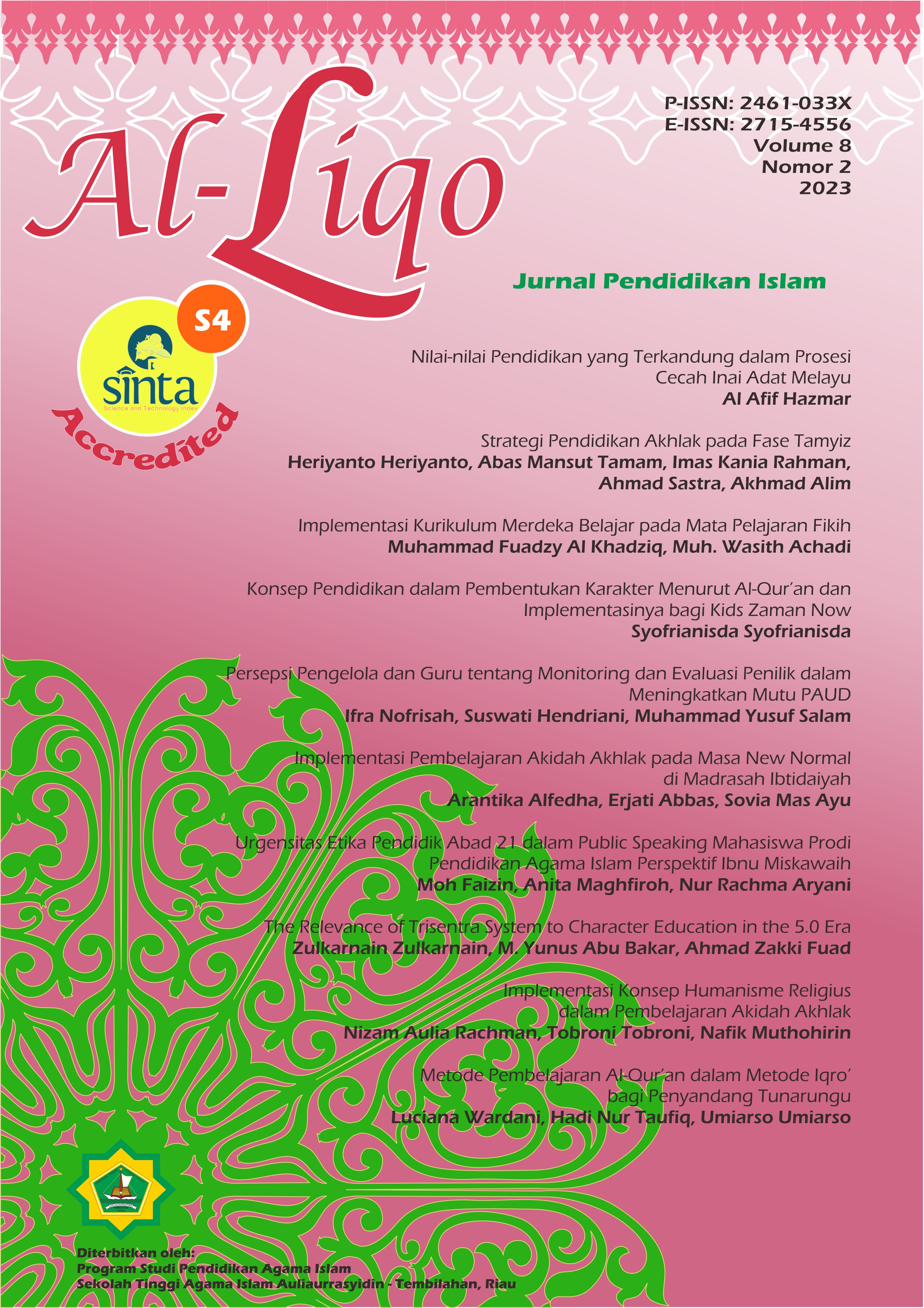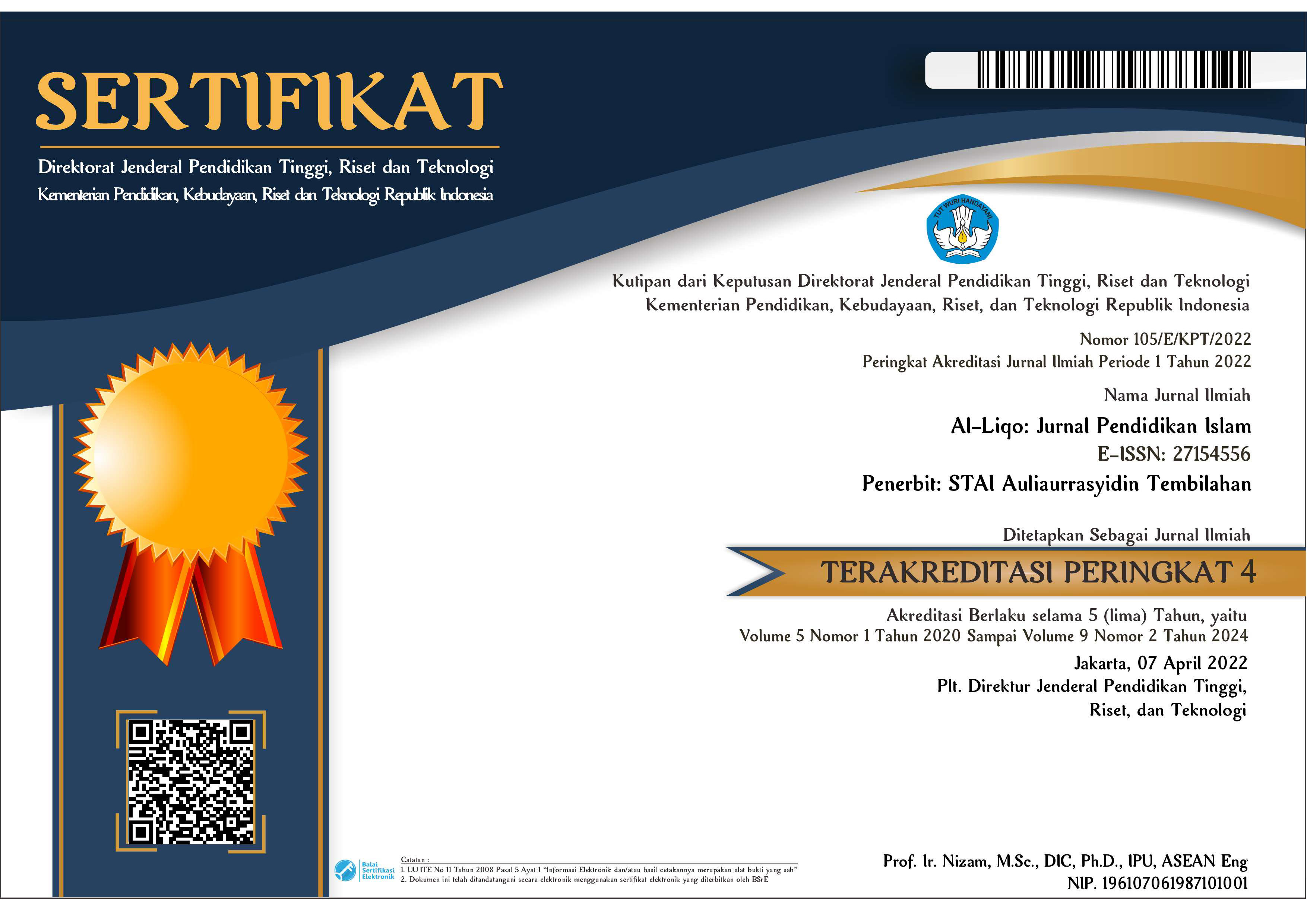Nilai-nilai Pendidikan yang Terkandung dalam Prosesi Cecah Inai Adat Melayu
DOI:
https://doi.org/10.46963/alliqo.v8i2.1474Keywords:
Value, Education, Cecah, HennaAbstract
This study aims to find educational values in a traditional tradition in Indragiri Hulu Regency, namely cecah henna. Cecah henna consists of three parts, namely breaking plain flour, breaking henna, and spreading turmeric rice to the bride and groom who have carried out the marriage ceremony. The series of henna henna rituals is carried out after the evening prayer which begins with the procession of the marriage contract as a religious ritual and is continued with the henna henna as a symbol of giving blessings to the bride and groom from the family and villagers. This research is qualitative research carried out in Indragiri Hulu Regency in 2022 with research informants, the Chairperson of the LAM-R of Indragiri Hulu Regency, the Chairperson of the LAM-R of Rengat, Rengat Barat and Kuala Cenaku Districts and an Islamic Religious Education Teacher. The data collection technique used was by observing, interviewing, and documenting and analyzed by reducing the data obtained, presented, and verified. The results of the study show that in the tradition of cecah henna it means a cool household, adhesive for affection and increasing sustenance. Besides that, there are also 3 main educational values, namely: maintaining harmony and peace, maintaining eternal affection, and creating prosperity. If these three values are put together then it can be crystallized in the value of faith in Allah SWT.
Downloads
References
Ali, M, D. 2010. Pendidikan Agama Islam. Jakarta: PT. Raja Grafindo Persada.
Al-Qur'an dan Terjemahan Kementerian Agama RI, https://quran.kemenag. go.id/
Arikunto, Suharsimi. 2010. Prosedur Penelitian Suatu pendekatan Praktek. Jakarta: Rineka Cipta.
Arsyila Indri Ayu, 2018 “Nilai-Nilai Pendidikan Islam Yang Terkandung Dalam Acara Sanggring Di Desa Mulya Asri Kecamatan Tulang Bawang Barat Kabupaten Tulang Bawang Tengah"
Bungin Burhan, 2011. Metodologi Penelitian Sosial dan Ekonomi, Jakarta: Air langga University Press.
Effendy Tenas, 2004. Tunjuk Ajar Melayu. Yogyakarta: Adicipta Karya Nusa
Gunawan Hendra, 2017. Nilai-Nilai Pendidikan Islam Dalam Tradisi Pernikahan Sebambangan Di Lampung Pesisir desa Bangun Negara kecamatan Pesisir Selatan kabupaten Pesisir Barat
Hamidy, 2012 Jagad Melayu dalam Lintas Budaya di Riau, Pekanbaru : Kajian Masyarakat Melayu
Indranatas Iskandar, 2008, Pendekatan Kualitatif untuk Mengendalikan Kualitas, Jakarta: Universitas Indonesia
Ihsan Faud, 2010. Dasar-Dasar Kependidikan, Jakarta : Rineka Cipta
Kamus Besar Bahasa Indonesia, https://kbbi.kemdikbud.go.id/
Kartono Kartini, 2002. Pengantar Ilmu Pendidikan Teoritis, Bandung: Mandar Maju
Kurniati Fatia Dan Kuswarsantyo “Makna Filosofi Tari Persembahan Dan Kaitannya Terhadap Karakter Masyarakat Kota Pekanbaru Provinsi Riau”
Lubis Idrus dkk, 2001. Kamus Bahasa Indonesia- Melayu Riau, Jakarta: Pusat Pembinaan, dan Pengembangan Bahasa
Mahfud Chairul, Pendidikan Multikultural. 2016.Yogyakarta: Pustaka Belajar
Poerwadaminta. WJS, 2014. Kamus Umum Bahasa Indonesia, Jakarta: Balai Pustaka
Ramayulis, 2010. Metodologi Pendidikan Agama Islam. Jakarta: Kalam Mulia
Sadulloh, U. 2011. Pedagogik (Ilmu Mendidik). Bandung: Alfabeta.
Sanusi Ahmad. 2017. Sistem Nilai: Alternatif Wajah-Wajah Pendidikan, Bandung: Nuansa Cendekia
Sebambangan Di Lampung Pesisir Desa Bangun Negara kecamatan Pesisir Selatan kabupaten Pesisir Barat
Sugiono, 2015. Metode Penelitian Pendidikan Jakarta: Alfabeta
Takari Muhammad bin Jalin, Memahami Adat dan Budaya Melayu. Medan: Program Studi Etnomusikologi FIB USU dan Majlis Adat Budaya Melayu, Indonesia
Downloads
Published
Issue
Section
License
Copyright (c) 2023 Al Afif Hazmar

This work is licensed under a Creative Commons Attribution-ShareAlike 4.0 International License.
Authors who publish with this journal agree to the following terms:
1. Copyright on any article is retained by the author(s).
2. The author grants the journal, right of first publication with the work simultaneously licensed under a Creative Commons Attribution shareAlike 4.0 International License that allows others to share the work with an acknowledgment of the work’s authorship and initial publication in this journal.
3. Authors are able to enter into separate, additional contractual arrangements for the non-exclusive distribution of the journal’s published version of the work (e.g., post it to an institutional repository or publish it in a book), with an acknowledgment of its initial publication in this journal.
4. Authors are permitted and encouraged to post their work online (e.g., in institutional repositories or on their website) prior to and during the submission process, as it can lead to productive exchanges, as well as earlier and greater citation of published work.
5. The article and any associated published material is distributed under the Creative Commons Attribution-ShareAlike 4.0 International License







2.png)



